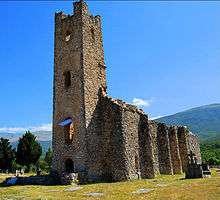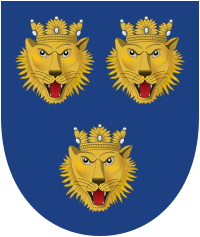Church of Holy Salvation, Cetina
The Church of the Holy Salvation (Croatian: Crkva Sv. Spasa) is a Pre-Romanesque church in northern Šibenik-Knin County, Croatia. It is located in the small village of Cetina, in inland of Dalmatian Hinterland, near the spring of the river Cetina, 8 km northwest from the town of Vrlika.
| Church of Holy Salvation | |
|---|---|
| Crkva Svetog Spasa | |
 Church of Holy Salvation | |
 Church of Holy Salvation | |
| Location | Cetina, Croatia |
| Country | |
| Denomination | Pre-Schism Christian |
| Architecture | |
| Years built | 9th century |
| Part of a series on the |
| Catholic Church in Croatia |
|---|
|
History History of the Catholic Church in Croatia History of Croatia–Holy See relations Historical dioceses Diocese of Dubrovnik Diocese of Ston Archdiocese of Zadar Archdiocese of Split Diocese of Šibenik Diocese of Nin Historical people Gregory of Nin Historical sacral architecture Church in Nin Church in Cetina Church of St Donatus |
|
Organisation Episcopal Conference of Croatia Dioceses List of dioceses Archdiocese of Zagreb Archdiocese of Split-Makarska Diocese of Hvar-Brač-Vis Archdiocese of Rijeka Archdiocese of Đakovo-Osijek Schools Archdiocesan Gymnasium Zagreb Pontifical Croatian College Catholic University of Croatia Political Croatian Catholic movement Media Croatian Catholic Radio Other Military Ordinariate of Croatia Apostolic Nunciature |
|
Clergy Pope Francis Ordinaries Josip Bozanić · Josip Mihalović · Franjo Kuharić · Franjo Šeper · Juraj Haulik · Antun Vrančić Juraj Drašković · Aloysius Stepinac |
|
Canonized people |
|
Churches & shrines |
|
This church is quite important in Croatia, as it is the only pre-schism church constructed with a bell tower which is still standing.
Description
It was a large stone church for that period. The church is a one-longitudinal-nave structure with a sanctuary consisting of three apses, in the form of a trefoil. Later, the middle apse was pulled down and substituted by a bigger, rectangular one. The church has strong semi-circular buttresses that give a feeling of fortification, emphasized with mighty bell-tower positioned in front of entrance, creating a westwork.[1]
History

The church was built near Vrlika, called Vrh Rike in the 9th-10th century.[2] It was dated to the time of Duke Branimir of Dalmatian Croatia through comparative analysis of an altar beam with other artefacts carrying Branimir's name by Ivo Petricioli in 1980 and 1984.[3] It is one of the oldest and best preserved larger monuments of the early pre-Romanesque sacral architecture.[4]
The church was built by the local župan (district-prefect) Gastika of Cetina, at the recommendation of Pope Stephen VI, but as a private church, built in memory of his family.[5] The most important is the fragment of a beam with semi-uncial inscriptions from it is known that the church had been dedicated to Christ and built on the order of the prefect Gastika, the son of Nemira.[6]
The graves found near the Church, dated to the 9th through 14th century, had a specific kind of textile that was found to be comparable in quality with 18th and 19th century clothing.[7] There are over 1,026 old Croatian graves around the church of great archaeological interest.[2] Several tombs have been found in the church itself, most of which (more than 800) originally had stećci. The culture of that time was influenced by the Frankish Empire, which was noticed in the archaeological findings from the period and the structure of the church.[6]
In the early 15th century, Hrvoje Vukčić strengthened the Prozor Fortress, and most of the inhabitants moved out of Vrh Rika into Vrlika. The fortress subsequently belonged to Ivaniš Nelipac, Ivan Frankopan and Mihača Nikolin Vitturi. After a 1492 invasion by the Ottoman Empire, the church and the settlement sustained heavy damage and a substantial part of the inhabitants fled to Turopolje.[2]
The Serbian Orthodox Eparchy of Dalmatia published a conflicting assessment of the origin of the Holy Salvation,[8] originally published by Mirko Ležaić in 1939 in Belgrade, saying Tvrtko I built it, and that it was destroyed by the Turks in 1512.[9] The Serbian name of the church is the Ascension of the Lord (Serbian: Храм Вазнесења Господњег).[10] In 1940, the new church of the Ascension of the Lord was built by Marko Četnik and his wife Jelena.
See also
- Architecture of Croatia
- Church of Saint Cross
- Church of St. Donatus
- Hollow Church
- Church of the Ascension of the Lord, Cetina
References
- Jurković 1995.
- "Povijest" [History]. Official site of Vrlika (in Croatian). Archived from the original on 2013-02-18. Retrieved 2013-02-26.
- Jurković 1995, p. 63.
- Jurković 1995, p. 55.
- Jurković 1995, pp. 63–64, 75.
- "RKT župa Gospe Ružarice - Crkva sv. Spasa, Cetina" (in Croatian). Municipality of Vrlika. Archived from the original on 2013-04-24. Retrieved 2013-02-26.
- "Znanost u Hrvata: prirodoslovlje i njegova primjena" [Centuries of Natural Science in Croatia: Theory and Application] (in Croatian). June–October 1996. Archived from the original on 2011-05-18. Retrieved 2010-10-03.
- "Crkveni život" (in Croatian). Municipality of Civljane. Archived from the original on 2013-08-26. Retrieved 2013-02-26.
- "Borba za veru, crkvu i prosvetu". Krka (in Serbian) (42). 2010. Retrieved 2013-02-26.
Za manastir Dragović «v čast Presvjatija Djevi Mariji i roždestva jeja». Milaš misli da je bio osnovan 1395. god. Njegov postanak tradicija dovodi u vezu sa bosanskim kraljem Stefanom Tvrtkom I, koji je opet «po ženskoj lozi» bio u rodu s Nemanjićima i koji je na vrelu Cetine ozidao crkvu «sv. Spasa», koju su Turci razorili 1512. g. Ruševine sa bogumilskim stećcima vide se još i danas.
- Radulović, Vaska (8 June 2018). "Cetina: Church of Holy Salvation". srbi.hr. Retrieved 1 March 2020.
Sources
- Jurković, Miljenko (December 1995). "Sv. Spas na vrelu Cetine i problem westwerka u hrvatskoj predromanici" [The Church of the Saviour at the Source of the Cetina River and the Westwork in the Croatian Pre-Romanesque]. Starohrvatska prosvjeta (in Croatian). Split: Museum of Croatian Archaeological Monuments. III (22): 55–80. ISSN 0351-4536. Retrieved 2020-06-19.
- Marasović, Tomislav (December 1995). "Crkva Sv. Spasa na vrelu Cetine: Prilog tipološkoj analizi" [The Church of st Saviour at the Source of the Cetina River]. Starohrvatska prosvjeta (in Croatian). Split: Museum of Croatian Archaeological Monuments. III (22): 37–54. ISSN 0351-4536. Retrieved 2020-06-19.
- Petricioli, Ivo (December 1995). "Crkva Sv. Spasa na vrelu Cetine" [The Church of the Holy Saviour at the Source of the Cetina River]. Starohrvatska prosvjeta (in Croatian). Split: Museum of Croatian Archaeological Monuments. III (22): 19–28. ISSN 0351-4536. Retrieved 2020-06-19.
Further reading
- Soldo, Josip Ante (2001). Vrlika - Monografija (in Croatian). Šibenik: Viatoni. ISBN 953-98670-0-2.
External links

